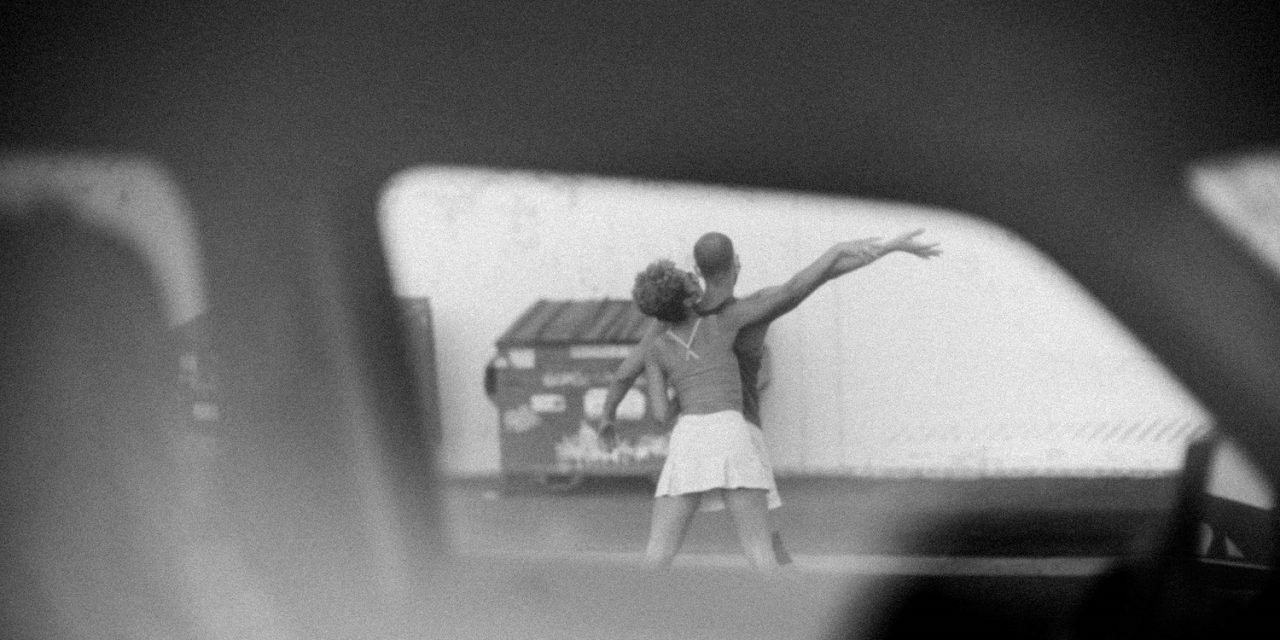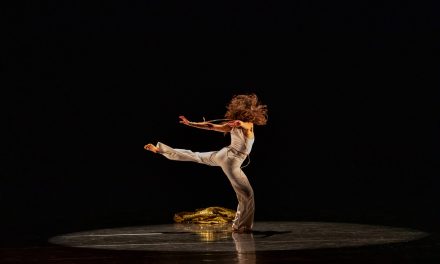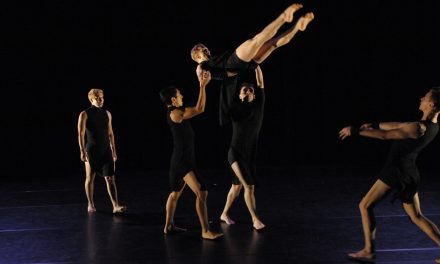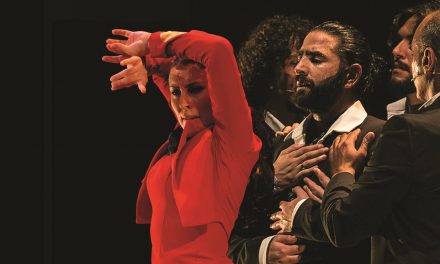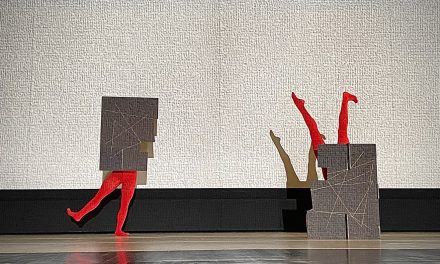“Forget what you think a performance is. Because this performance is not that performance is not…”
David Adrian Freeland, Jr. takes the mic at the beginning of The Betweens to say this, to disrupt one’s idea of audience, of performance, of stage dance. This sentiment – this blowing up the constructs of performance – is common in Jermaine Spivey and Spenser Theberge’s work, and by its very nature keeps their work relevant and revolutionary. In the case of L.A. Dance Project’s The Betweens, it recontextualizes pandemic themes beyond the literal and makes them refreshing, hopeful, and even applicable to life outside of COVID-19. It’s the type of art I’ve been dreaming of, reaching for, since last March.
LADP’s “Drive-In Dances” series ran last fall, including both The Betweens, created by Spivey and Theberge in collaboration with the dancers and Solo at Dusk, by choreographer Bobbi Jene Smith in collaboration with Or Schraiber. Tickets were expensive, and car capacity was small due to space and gathering restrictions, so a 24-hour streaming event between Saturday and Sunday made the show a bit more accessible for a community widely affected by the pandemic.
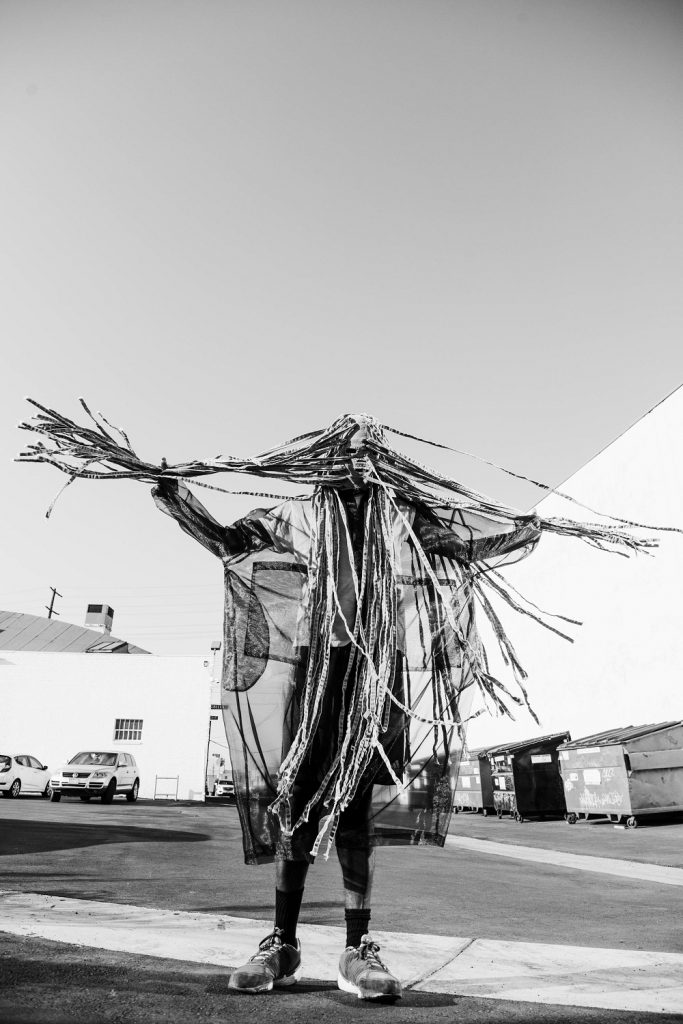
Mario Gonzalez rehearsing “The Betweens” by Jermaine Spivey and Spenser Theberge – Photo courtesy of LADC
This particular piece was framed around concepts of displacement, replacement, and engagement – and while those concepts are distinctly apt for this pandemic period, they’re not just that. They’re universal, and Spivey, Theberge, and the dancers explored them in the abstract. While a Zoom dance from the living room is perfectly acceptable given the circumstances, they have quite frankly burned me out on the form, and even left me to mourn the fate of dance itself as we faced gathering restrictions for so many months.
This work made me new again: camera work by Trevor Tweeten was well-choreographed and adapted to improvisation, a rare luxury in the world of screen dance. Original score by Maxwell Transue and sound design by Gahyae Ryu made the space feel full and disorienting and inviting, all at once. And costumes by Rebma Salad for 69 were built of practical whimsy, made for layered swapping and shifting but quirkily coherent throughout the half hour.
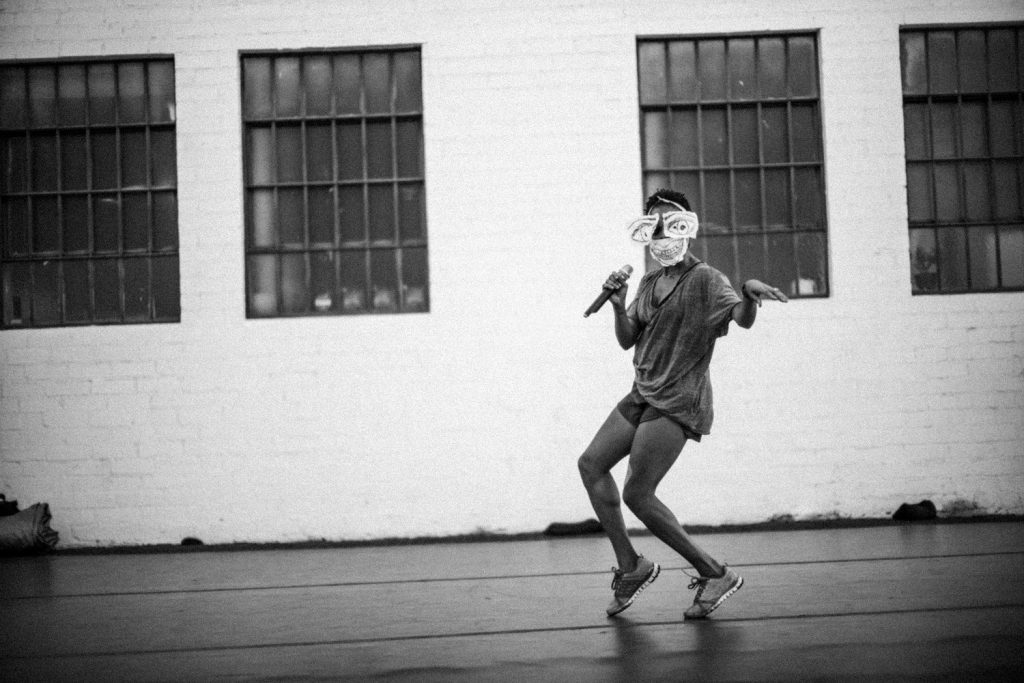
Yusha-Marie Sorzano rehearsing “The Betweens” – choreography by Jermaine Spivey and Spenser Theberge – Photo courtesy of LADP
The dancers came in revving, in a unison movement cohort featuring quick shifts and, yes, displacement. The movement throughout the work echoed the three central pillars (again: displacement, replacement, engagement). Seconds later, they assumed their microphones. In Spivey and Theberge’s work, the vocal articulation of the doing and the dancing is comforting. But it’s also a sure way to attribute agency to the dancers. They’re allowed to be entirely themselves throughout the piece.
“You’re always the person you are,” Theberge told LADP member Rachelle Rafailedes in a Zoom Q&A about their process (included in the streaming package), when she asked if the two were always comfortable speaking onstage.
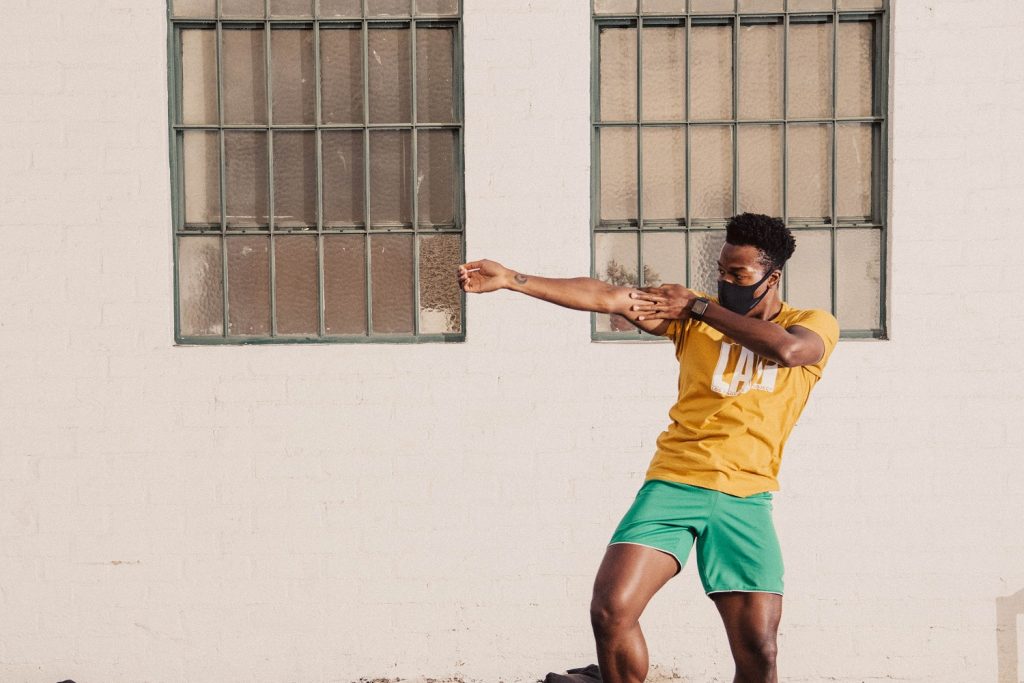
David Adrian Freeland, Jr. rehearsing “The Betweens” – choreography by Jermaine Spivey and Spenser Theberge – Photo courtesy of LADP
They both shook their heads and laughed. Theberge explained that he stopped separating dance from his self and his research once he realized that he was himself wherever he went – onstage or not. He and Spivey sort of narrate themselves in their last two evening-length works, Rather This, Then and Position 3, and even in a recent film work for the Broad Stage. They’ve honed this voice that is simultaneously so routine and so farcical. It’s a humorous performance of self, and any dancer will enjoy their caricatured whispers: “Jermaine, look at this!” and “oh, I love that.”
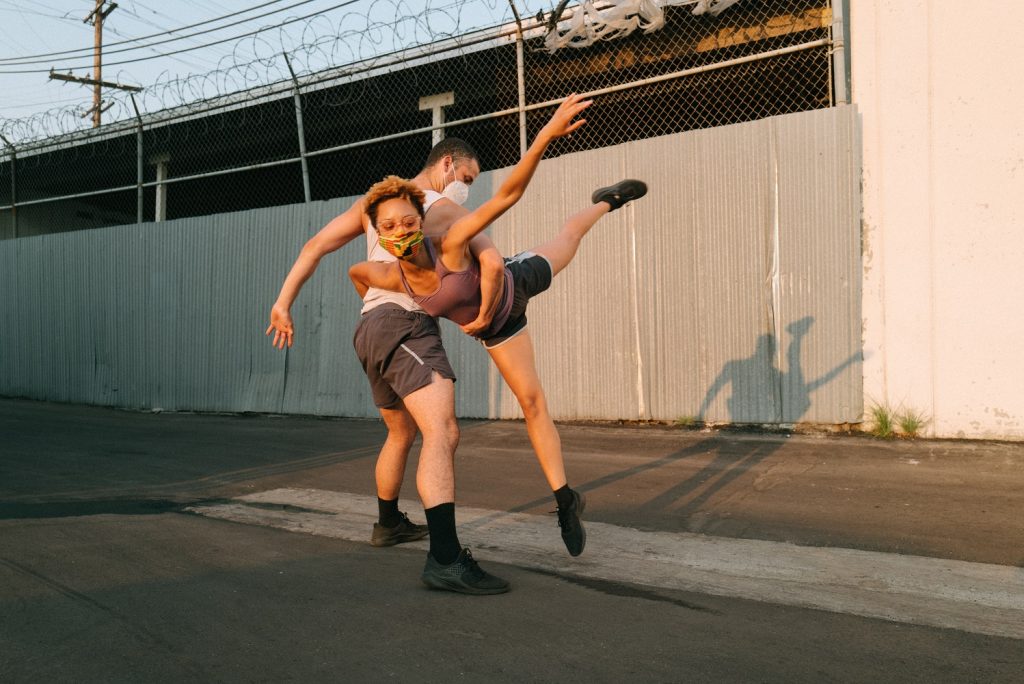
Nayomi Van Brunt and Mario Gonzalez rehearsing “The Betweens” – choreography by Jermaine Spivey and Spenser Theberge – Photo courtesy of LADP
This mode of humor is translated for other humans in The Betweens, which is seemingly a continuation of the duo’s identity explorations with a few new team members. David Adrian Freeland, Jr., Mario Gonzalez, Nayomi Van Brunt, and guest artist Yusha-Marie Sorzano bring curious commitment to the work, which is absolutely necessary in a piece like this: site specific and on-camera, mic’d, with a small cast of four. They play, displace, and replace, and are hilariously engaged with each other and the camera. When the choreographic cues ask that they fall into dissonance, they keep their wits about them, kinetic sense of each other so sharp that a return to unison is flawless and incredibly satisfying. Their eyelines direct the camera and the viewer kindly, showing us how and where to look.
The sound comes in as a fifth cast member. Transue creates seamless disruption, flowing easily in and out of echoing skips and smooth serenades. Ryu’s design shapes the space when the camera doesn’t capture the whole set, placing an at-home viewer in the 2245 parking lot. The sound assumes several directions at once, allowing you as an audience member to feel displacement as well.
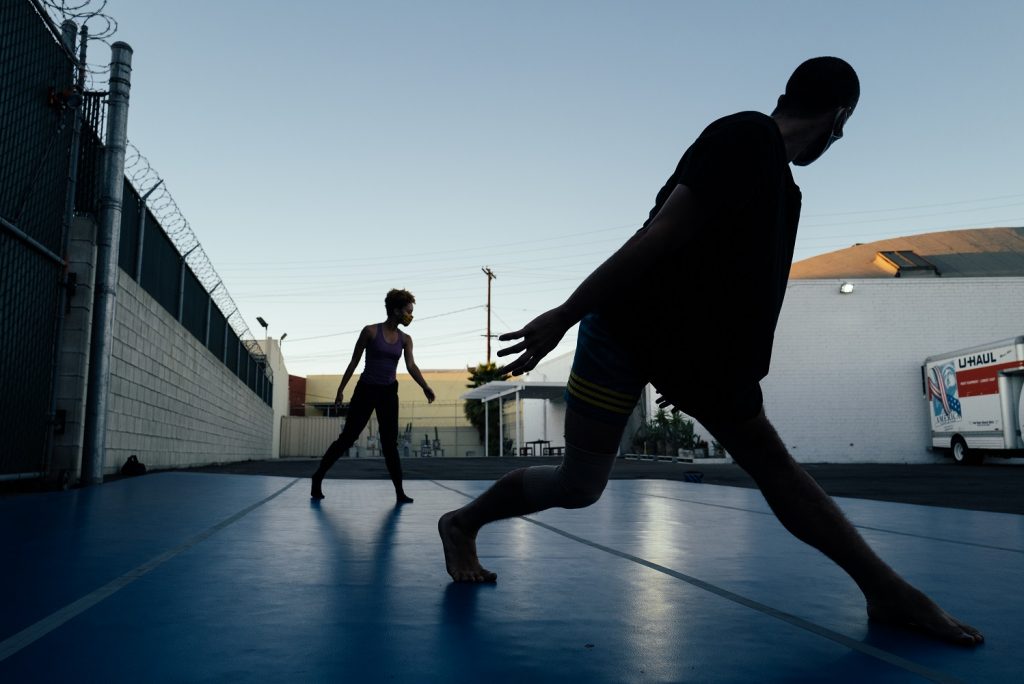
Nayomi Van Brunt and Mario Gonzalez rehearsingl “The Betweens” by Jermaine Spivey and Spenser Theberge – Photo courtesy of LADP
Freeland says, “insist that you resist this history of performance cycling through your body,” calling both dancers and audience to abandon presupposed notions of performance and just take in the thoughtfully spontaneous happenings before us. Whispers through the microphone lull us into an everyday rehearsal space before Freeland and Sorzano bring a full-on R&B duet to the ‘stage,’ complete with mic choreography and vocal runs.
The ending scenes poke fun at our paranoid policing of others: “are they touching?” “Are they allowed to touch?” Sorzano gasps, observing Gonzalez and Van Brunt in a brief contact duet. Her fascination and obsession with the touch and the rules accomplishes the impossible: making the pandemic funny and profound at the same time.
All of a sudden, I’m not disheartened by pandemic themes. The humanness of Freeland, Sorzano, Gonzalez and Van Brunt’s self-characters has inspired me to find my own, and I think there might be a way our art can survive.
To visit the L.A. Dance Project website, click HERE.
Written by Celine Kiner for LA Dance Chronicle.
Featured image: Nayomi Van Brunt and Mario Gonzalez rehearsing The Betweens – choreography by Jermaine Spivey and Spenser Theberge – Photo courtesy of LADP

